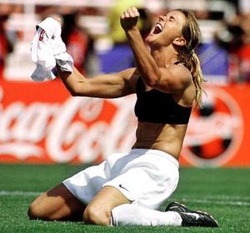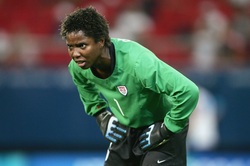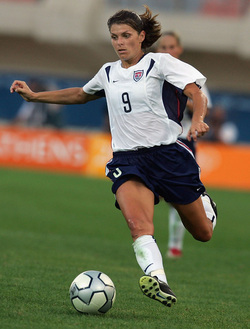|
It’s a pleasure to introduce my first guest post courtesy of Toni Rogers (@MzRogersHood). A life-long athlete and current sport administrator in college athletics, she offers a critique on how issues of gender and sexuality complicate the sporting experience for female athletes. I am a product of the “Girls of Summer.” The memory of the 1999 Women’s World Cup Final has left a lasting imprint in my mind, from the oft forgotten blocked penalty kick by Brianna Scurry, to the infamous shirtless celebration of Brandi Chastain and the hero that was Mia Hamm. My life has always been, and continues to be, consumed by sport; it is the one thing that has the ability to fill me with me complete joy, but also the power to overwhelm and frustrate. Mia Hamm and company had throttled themselves to the forefront of American sporting culture by the late 1990s, unlocking opportunities for young girls like me. Yet fifteen years later, the progress that female athletes have made is questionable.  Brandi Chastain. (Photo credit: Atkins/AP) Brandi Chastain. (Photo credit: Atkins/AP) Years ago, I idolized the beauty, grace, and poise that Hamm possessed. She was a marketer’s dream. Hamm was the “girl next door”: she was well spoken, talented, and importantly, had a pretty face. Still, a part of me was always instinctively drawn to goalkeeper Brianna Scurry. Her intensity was unlike anything I had seen. She made no apologies for her fierceness on the field or her failure to smile. At the time, I couldn’t understand why posters of Scurry were so hard to find, while my friends’ walls were littered with pictures of Hamm, Chastain, and Julie Foudy. After my many years spent as a player, coach and now administrator in athletics, the answer has become increasingly clear, but no easier to accept. The answer lies in the reasons my Little Tykes soccer team had to be named the “Queen Bees” rather than the “Killer Bees,” and why I found myself defending my own sexuality before I even truly understood it.  Brianna Scurry. (Photo credit: Shaun Botterill/Getty Images Sport) Brianna Scurry. (Photo credit: Shaun Botterill/Getty Images Sport) Women who possess the traditional norms of feminine beauty and behavior are thrust to the forefront of their sports. Since the emergence of Title IX, women have had an increasingly greater presence in athletics, whether at the grassroots level or in the professional realm. It is no longer uncommon to see women’s games on ESPN or other major networks, and some female athletes have become national (even global) sensations. But coupled with this presence is a trend in how the media and sporting culture choose to market and represent women’s sports. This observation is not meant to undermine the accomplishments of these women; Alex Morgan, Maria Sharapova, and Danica Patrick have all earned their rightful place at the top of their craft, yet their popularity is largely strengthened due to their physical appearance. This is not to say there are not exceptions. Abby Wambach has replaced Hamm as this generation’s face of women’s soccer. While she may not have the sex appeal of Morgan, her humility, unmatched abilities, and respect for those who paved the way have made her an undeniable force in the women’s sporting world. Serena Williams, who is arguably one of the best players in her sport’s history, is also an exception to this trend. However, as an African American female who is not afraid to push the envelope, her athletic skill and accomplishments are often undermined simply because she does not fit the “obedient” female mold.  Mia Hamm. (Photo credit: Scott Barbour/Getty Images Sport) Mia Hamm. (Photo credit: Scott Barbour/Getty Images Sport) This dichotomy between the “acceptable” feminine athlete and the “unacceptable” masculine athlete has caused an internal dilemma in the way I view women’s sports. Women have always struggled to legitimize their role in athletics, a male-dominated field where strength and power are paramount. This struggle is increased for those women who must find a comfortable balance between their athleticism and skill against the dainty frame, flawless skin, and pretty face which reign as the female beauty standard in modern culture.
In the short run, the publicity and national attention have provided unmatched opportunities for women, but I question the long term implications and potentially devastating effects on the culture of youth sports and young athletes. Women like Alex Morgan or Lolo Jones – and even the emergence of the Lingerie Football League – have drawn attention to the abilities of female athletes that had once been ignored. The Lingerie Football League has capitalized on this media culture, granting an opportunity for women to compete in a sport they have traditionally been ostracized from. Yet this league sends a conflicting message to young female athletes who perceive that their future in sport is based on the ability to sexualize their talents to appease the male gaze. Still, this national attention is what encourages the women’s professional soccer leagues to keep pushing, to not accept defeat. Yet again, it is also what causes young girls who may be “too tall” or have shoulders that are “too broad” to question their place in the sporting world and whether they can attain the same media attention as Hamm once did. This culture is what causes an intrusive speculation of girls’ sexuality, often at an age when they have yet to learn it themselves. It forces many young females to tirelessly defend their heterosexuality, as homosexuality is the perceived standard amongst women who may have “too many” tattoos or blemishes, muscles “too defined,” or even a haircut that is “too butch” – all of which are traits attributed to masculinity and even applauded in their male counterparts. While female athletes struggle less with coming out in comparison to males, they must fight harder to push their skill and abilities to the forefront of their persona. True growth in sport can never be attained until women are household names due to their talent, rather than appearance, relationship status, or sexual preference. Editor’s note: This article was first published atwww.thelibraryisopen.wordpress.com, operated by James Rogers (@ElliottJMR)
0 Comments
Leave a Reply. |
ARCHIVES
September 2022
|
 RSS Feed
RSS Feed